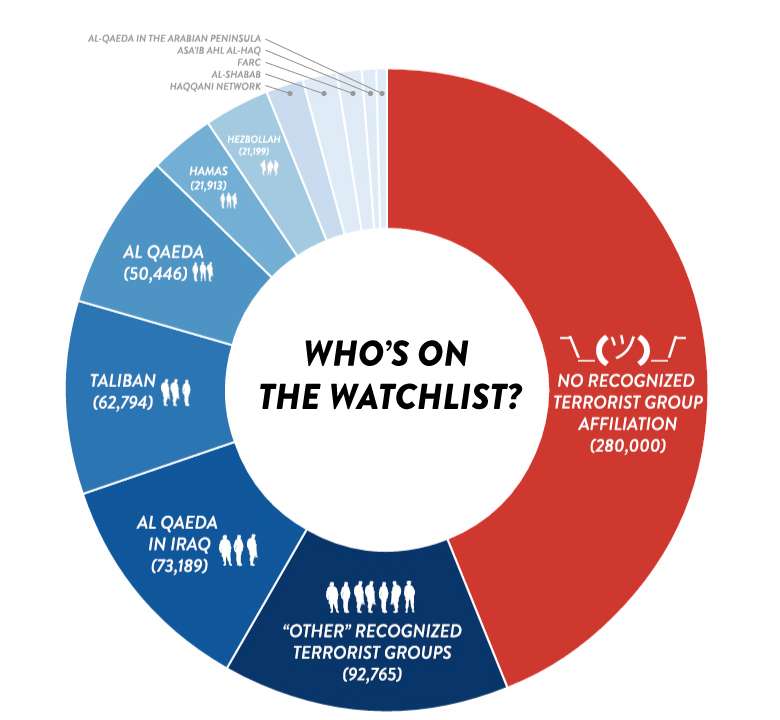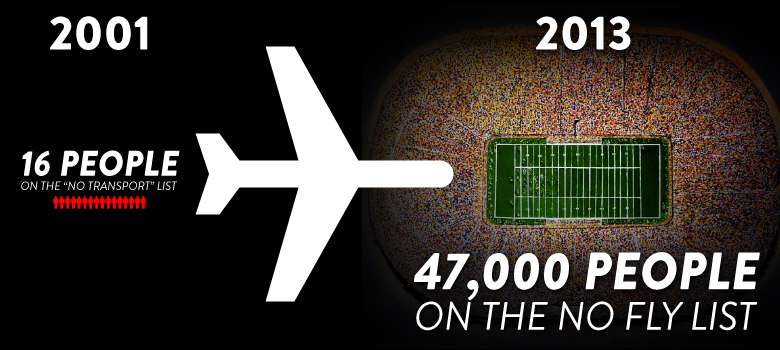What Kind of People Are on the Feds' Terrorist Watchlist Anyway?
Over one-third of the 680,000 suspected terrorists have "no recognized terrorist group affiliation."

Via The Intercept comes this immensely clarifying and depressing breakdown of just how many people are in the government's "Terrorist Screening Database," the master list of "known or suspected terrorists" that's shared with state and local law enforcement, government contractors, and foreign states. It also presumably supplies at least the first cut of the 47,000 people unluckly enough to be on the country's "no-fly list" (more on that in a moment).
Stunningly, 40 percent of the people in database—280,000—have "no recognized terrorist group affiliation." And dig this:
Although the Obama administration has repeatedly asserted that al Qaeda in the Arabian Peninsula poses the most significant external terrorist threat to the United States, the 8,211 people identified as being tied to the group actually represent the smallest category on the list of the top ten recognized terrorist organizations. AQAP is outnumbered by people suspected of ties to the Pakistan-based Haqqani Network (12,491), the Colombia-based FARC (11,275,) and the Somalia-based al-Shabab (11,547).
And what about the "no-fly list," which has emerged as the go-to source for cheap political points after the San Bernardino shooting? Just yesterday, in fact, Barack Obama started the #DoSomething hashtag campaign dissing anyone who thinks people on the list should be able to legally purchase guns. "If you're too dangerous to board a plane, you're too dangerous to buy a gun," argued the president, ignoring the voluminous complaints about the lack of accuracy and due process regarding the list.

The Intercept notes that the number of people on the list has increased tenfold since Obama took office:
The number is also a testament to the Obama administration's intensified collection of personal information on individuals with suspected links to terrorism. In 2006, CBS News obtained a copy of the no fly list and reported that it included 44,000 names, including Bolivian President Evo Morales and the head of Lebanon's parliament. Faced with a widespread public backlash, the government cut the list down to just 4,000 names by late 2009….
"You might as well have a blue wand and just pretend there's magic in it, because that's what we're doing with this—pretending that it works," says former FBI agent Michael German, now a fellow at New York University's Brennan Center for Justice. "These agencies see terrorism as a winning card for them. They get more resources. They know that they can wave that card around and the American public will be very afraid and Congress and the courts will allow them to get away with whatever they're doing under the national security umbrella."
Remember back when the whole Global War on Terrorism (GWOT) was just getting started and all sorts of pols, pundits, and experts kept talking about finding needles in haystacks? It turns out that Obama's version of GWOT is less about finding more needls and more about creating bigger haystacks.
Back in 2011, Reason TV talked with Mike German, who's quoted above. A former FBI agent who infiltrated white supremacist groups in the Pacific Northwest, he became a lawyer and worked at the ACLU before joining NYU's Brennan Center. Below, he talks about the threats to civil liberties posed by mass collection of data simply because technology—and the law—allows it.


Show Comments (24)